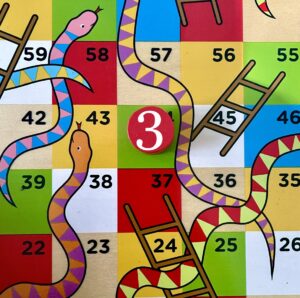 A few days ago, I bought a set of mixing bowls in primary colours. RED, BLUE, AND GREEN, as well as PURPLE, YELLOW and LIGHT BLUE, all nestling one inside the other like Russian dolls. I will probably use these for their stated purpose, but my primary desire to have these bowls in the house relates more to a need for psycho-spiritual equanimity, rather than making food prep more time and labour efficient.
A few days ago, I bought a set of mixing bowls in primary colours. RED, BLUE, AND GREEN, as well as PURPLE, YELLOW and LIGHT BLUE, all nestling one inside the other like Russian dolls. I will probably use these for their stated purpose, but my primary desire to have these bowls in the house relates more to a need for psycho-spiritual equanimity, rather than making food prep more time and labour efficient.
One underlying principle of inner harmony might be summarised by the somewhat mystical idea of The Law of Three which is embedded in Western and Eastern philosophy stretching all the way back to Pythagorus.
This law states that every event, phenomenon, or process in the universe is a result of three interacting forces: Active, Passive, and Neutral (or alternately: Affirming, Denying, and Reconciling).
So for example, in PERSONAL DEVELOPMENT:
- Affirming force: The desire for self-improvement or personal growth.
- Denying force: The resistance or obstacles that one encounters such as personal limitations, fears, or doubts.
- Reconciling force: The transformation or overcoming of these limitations, resulting in personal growth and the achievement of one’s goals.
In RELATIONSHIPS:
- Affirming force: The attraction, love, or shared interests between two individuals.
- Denying force: The differences, misunderstandings, or conflicts that arise within the relationship.
- Reconciling force: The resolution of these conflicts and the growth and deepening of the relationship as a result.
Once you become aware of this Law, it can be seen everywhere in the culture, as well as in our own private consciousness.
For example in our religious traditions, we see the Law of Three everywhere.
In Christianity:
- The Father/Mother/God figure – which is the Affirming force (the creator).
- The Son or Daughter as the Passive or Denying force (the manifestation of God in human form)
- The Holy Spirit as the Reconciling force that connects believers to the Divine.
In Hinduism:
- Trimurti of Brahma (Affirming: creation)
- Vishnu (Denying: preservation)
- Shiva (Reconciling: destruction).
In Judaism: Jews talk about “Three Pillars” of their faith.
- Torah (the Affirming force): represented by sacred texts and teachings, providing guidance for ethical living and spiritual growth.
- Avodah (the Passive or Submitting force): which involves worship and prayer, cultivating a personal relationship with the divine.
- Gemilut Hasadim (Reconciling force): Acts of loving-kindness, compassion, and social responsibility, which connect the individual to their community and the broader world.
This is also reflected in Islam, in what is known as Iman:
- Tawhid (Affirming force): the belief in the Oneness, Unity and Transcendence of the Divine.
- Prophethood (Passive/Submitting force): which acknowledges those prophets sent to guide humanity
- Akhirah (Reconciling force): which has its focus on the afterlife where it is thought that each of us will be held accountable in some way for our actions and will be rewarded or punished accordingly.
And then of course in Buddhism, which doesn’t deal in deities, we have what is known as The Three Marks of Existence – three fundamental characteristics of all conditioned phenomena in the universe:
- Anicca (Impermanence/Affirming force): The understanding that all conditioned things, including us, and our thoughts, emotions, physical responses are in a constant state of flux and change.
- Dukkha (Suffering or Anxiety/Denying force): The acknowledgment that unsatisfactoriness and suffering are inherent in life due to our instinctual and mind/body/heart-led forms of attachment and clinging.
- Anatta (Non-self, Liberation/Reconciling or Neutral force): The realisation that there is no permanent, unchanging self or essence, which may, hopefully, lead to some a greater ability to let go of those unhelpful attachments and other forms of suffering which our Egoic Engines get fixated on.
The Law of Three is also present in every film or television series, every narrative in fact, from fiction to non-fiction, where we generally find:
- A Protagonist (Affirming force): The main character, who drives the story forward and pursues a goal, the Hero’s Journey, if you like.
- An Antagonist (Denying force): The character or circumstances opposing the protagonist, creating conflict and tension in the story.
- A Resolution (Reconciling force): The climax and conclusion of the story, where the protagonist and antagonist’s conflict is resolved, often leading to the protagonist’s growth or transformation.
THE LAW OF THREE AS IT PERTAINS TO OUR DAILY, LIVED-EXPERIENCE
 What I want to focus on here though, is the Law of Three as it pertains to our own first-person consciousness, and how by focusing on the personality or Ego-driven imbalances of our tripartite inner system, we might acquire more balance and harmony between these three different aspects of our being. This is mainly what I’m intending to use my colour-coded mixing bowls for.
What I want to focus on here though, is the Law of Three as it pertains to our own first-person consciousness, and how by focusing on the personality or Ego-driven imbalances of our tripartite inner system, we might acquire more balance and harmony between these three different aspects of our being. This is mainly what I’m intending to use my colour-coded mixing bowls for.
As a guiding principle, we might say that within our consciousness the Law of Three is most present in two human animal systems.
Firstly, our ANIMAL-HUMAN INSTINCTS, which are shared with all other mammals on this planet. We all possess the following three instincts:
- An Affirming Instinct (Sexual/One-on-One Instinct): The sexual instinct drives procreation, attraction, and intimate bonding between individuals. This force is fundamental to the continuation of our species and the formation of deep emotional connections.
- A Denying Instinct (Self-Preservation Instinct): The self-preservation instinct ensures the survival, safety, and well-being of the individual. It involves the physiological and psychological processes that protect and maintain our health and security.
- A Reconciling Instinct (Social Instinct): The social instinct fosters interpersonal relationships, cooperation, and group cohesion, which are essential for human survival and flourishing. It involves the need to belong, connect, and contribute to a community or group.
The next Law of Three involves three Interrelated INTELLIGENCE CENTRES, comprising of an:
- Affirming Intelligence Centre (Head/Mental Intelligence): This centre is associated with the rational, analytical aspect of the mind, focusing on gathering information, problem-solving, and strategic planning.
- Denying Intelligence (Heart Centre/Emotional Intelligence): This centre is associated with the emotional and relational aspects of the self, focusing on empathy, connection, and self-expression.
- Reconciling or Neutral (Gut Centre/Somatic Intelligence): This centre is associated with the instinctual, somatic aspect of the self, focusing on physical presence, action, and intuition.
Let’s now look at each of these in turn and see what they have to do with mixing bowls and less philosophical but more practical ways of living our lives.
THE LAW OF THREE INSTINCTUALLY
 Let’s start with the most primal layer of our human consciousness which is our Life Force comprised of the three Instincts we’ve just focused on the one-on-one sexual, social, and self-preservation instinct. These instincts or energies, like the Engine of a car provide the primary drives behind most of our doing, feeling and thinking. Our instincts are shared with every other mammal, and thus largely function at an unconscious level.
Let’s start with the most primal layer of our human consciousness which is our Life Force comprised of the three Instincts we’ve just focused on the one-on-one sexual, social, and self-preservation instinct. These instincts or energies, like the Engine of a car provide the primary drives behind most of our doing, feeling and thinking. Our instincts are shared with every other mammal, and thus largely function at an unconscious level.
Let’s make them conscious and concrete though by imagining them as:
- A PURPLE BOWL: for that more intimate, One-on-one Instinct, think Prince
- A YELLOW BOWL: for that Social Instinct which shines warmly like the sun, think Herbie Hancock
- A LIGHT BLUE BOWL: for that Self-Preservation Instinct, a kind of “Inner-Sky” which seeks to provide a nurturing environment for our own well-being, think Lizzo.
All three instincts working as a dynamic system at any given time, but as you read/listen to the description of these three bowls, see if you might start stacking them in the order in which they show up in your life.
Each Instinct, each mixing bowl, particularly when it is working at an unconscious level brings with it various advantages and disadvantages for our conscious experience of life.
Let’s first look at THE LIGHT BLUE MIXING BOWL (Self-Preservation/Lizzo) representing our core, self-preservation, survival instincts. As humans, this instinct materialises into a focus on money, health, wellness, food, diet, exercise, sleep quality, sensuality and physical pleasure, insurance, decor, ambiance, vitality, comfort, routines, conservation, grounding/stability, emotional and physical safety, as well as resource acquisition and hoarding (Mosley, 2022).
If this is your dominant mixing bowl, the one that holds the other two, you might often feel a conscious and constant tracking of your energies with regard to self-care, resources and domestic comforts, so as to ensure that whatever is deemed necessary for survival in these domains is adequate if not plentiful.
When this Instinct picks up a threat or deficiency in your self-preservation realm, this will create worrying, fretting and strategizing so as to create the grounding, security and comfort that you need.
Now let’s imagine THE PURPLE MIXING BOWL (SX, the Prince Instinct) represents the very opposite of this, the force for self-preservation.
The Purple Bowl represents our Intimate/One-on-One Instinct or Sexual Instinct, seeking intimacy and connection, as well as profound emotional experiences both within ourselves, but also with other living beings (human as well as non-human) and even the Divine. This Instinct pushes us to explore the deeper aspects of human relationships so as to ultimately know ourselves and others more intimately. For this reason, it is also our most competitive instinct, focused around attraction, intimacy and desirability, as well as lovablity, both in romantic and non-romantic relationships. The Sexual or Intimate Instinct also rules over the domains of secrets, mysteries, personal adornment, relational power dynamics, depth of connection, fascination, intensity, eye contact, obsession, as well as repulsion.
The third bowl, THE YELLOW MIXING BOWL (Social, The Herbie Hancock Instinct), in this case lies somewhere between the two poles of Self-Preservation and Self-Other fusion, or blending, or merging. This social, YELLOW BOWL is, like the one-on-one instinct, relational, but in a more chilled-out, less intense way than the One-on-One/Intimate/Sexual instinct. This Instinct is more about groups: friends, family, belonging, gossip, fame, notoriety, lawmaking, hierarchies, philanthropy, trends, cultural narratives, history, government, religious and cultural customs. Also: social rituals, team-building/making, bullying as well as anti-bullying, honour, shame, and the creation of ideological paradigms like psychotherapy, liberalism, conservatism, feminism, environmentalism, intersectionality, as well as our various psychotherapeutic paradigms.
BOWL/INSTINCT STACKING
If I were to stack my three primary-colour mixing bowls in terms of how they hold as well as shape my basic life force, the energy that brings the self I call “me” into the world each day, as well as guiding this “me” through my human-animal experience, I tend to perceive to the purple mixing bowl, which is to say my Intimate, One-On-One Instinct as that which takes up, as well as holds the most batter, or mixture in terms of where my energies get focused.
REFLECTION: Have a think about these three instincts and decide which bowl , for you, holds the the other two in place, less dominant instincts in place? In what way is your life made “better” or “worse” by having this unconscious instinct mainly driving your focus of attention and behaviour? Think also about how the other two instincts serve the needs of this dominant one, and also which of your three instincts doesn’t get much of a look-in? Which instinct is “repressed” in some way by the other two?
Here are some of the pros and cons of having each instinct as our dominant or primary life-force:
OUR INTIMATE/ONE-ON-ONE (Purple) INSTINCT: This instinct enhances emotional and physical intimacy in relationships, both romantic and non-romantic. It contributes to our sense of pleasure, excitement, and satisfaction in all we do and everyone we connect to, encouraging self-expression and creativity in various aspects of life.
BUT: it can also lead to unhealthy or compulsive behaviours, creating greater emotional vulnerability or dependency. It may also result in conflicts or misunderstandings in relationships when expectations are not effectively communicated, accepted or understood.
OUR SOCIAL (Yellow) INSTINCT: This helps us to foster interpersonal relationships and group cohesion, which are essential for human survival and flourishing, enhancing our communication, empathy, and cooperation, and promoting a sense of belonging, social support, and shared purpose.
BUT: It can also lead to excessive conformity, loss of individuality, or suppression of authentic self-expression in an effort to fit in with a group, contributing to social comparison, envy, or competition, which can negatively impact mental health and well-being; and may also result in unhealthy dependencies on social approval or validation, leading to low self-esteem or a lack of self-reliance.
OUR SELF-PRESERVATION (LIGHT BLUE) INSTINCT): This helps us to maintain our safety, and well-being, promoting a sense of security and stability, which can contribute to overall psychological health and resilience.encouraging planning, preparation, and adaptability in the face of challenges or threats.
BUT: It can also lead to excessive anxiety or fear, resulting in overly cautious or risk-averse behaviours, limiting our personal growth or the ability to have new or different experiences. Of all the instincts, it can also contribute to self-centeredness or egocentrism, particularly if it is prioritised above the needs or well-being of others.
THE INSTINCTS MEET OUR INTELLIGENCE CENTRES
Of course these instincts don’t operate in a vacuum. We might see them rather as a kind of energy or electricity which powers the Operating System of the human creature. As with the instincts, we all possess three different types of Operating Systems (head, heart, gut), but as with the instincts, one is often dominant. Within this dominant operating system we might “find ourselves” which is to say, land on the more complex, nuanced personality “type” we most identify with. This type, at its most basic level, is predominantly a combination of our Primary or Dominant Instinct and our Main Operating System.
Let’s sketch out the three Operating Systems, and then briefly look at what happens when each system gets inflected or “charged” by a particular instinct.
THE THREE INTELLIGENCE CENTRES

Our Three Intelligence Centres are a bit like the three Primary Colours of our world, which is why I have chosen to represent them by the RED, GREEN, and BLUE mixing bowls.
Energy in the physical world is encoded with information. To understand information is to have intelligence, which is why we human creatures all have three of these basic intelligence centres.
THE BLUE BOWL represents the MENTAL INTELLIGENCE of HEAD (Personality Types: 5,6,7)
The ability to gather, sort, analyse and interpret. It is from the head that we can build upon or refine information and work with conceptual frameworks.
In the head, thoughts proliferate
a flurry of cerebral activity
tangential, this way, suddenly that,
moving rapidly along neural pathways—
those familiar and those waiting to light up.
(BenAmi, 2023)
The Head manages fear. Our survival necessitates recognizing and responding to fear. The aim of addressing fear by the Mental Intelligence represents a search for security. Maybe all mentalizing is in some way a search for this security, which we then call Knowledge.
THE RED BOWL represents the EMOTIONAL INTELLIGENCE of HEART & SOUL (Personality Types 2,3,4)
Heart and Soul are where we know ourselves and connect most deeply. Emotions are forces that animate personality, build relationships, and give our lives meaning.
In the heart, feelings grow
pulling in and towards
they expand, well up inside us,
and sometimes, break us open.
They are the palette that colours our world.
(BenAmi, ibid)
The Heart manages shame. Shame is connected to our basic need to know and demonstrate our worthiness as we relate to ourselves, others and our environment. In some way, all our emotions are tied to Shame. The word’s roots are to be found in the proto-indo-european -skem, meaning “to cover”. Think Adam and Eve covering their genitals with leaves after eating the fruit of the forbidden tree. Shame is perhaps our most social emotion alongside Love.
THE GREEN BOWL represents the Somatic Intelligence of GUT (Personality Types: 8,9,1)
This is the most immediate and fundamental experience of ourselves, accessed via sensate awareness. To be is to have the gut intelligence of the body. The gut is the intelligence closest to our three Instincts.
In the gut, impulses fire,
a preliminary, decisive movement
in a certain and singular direction.
They occur at the core
and move us out, into action.
(BenAmi, ibid)
The Gut manages anger. Anger reminds us of what we value most and what our limits are. Anger is a natural response to that which is unjust; it is the force that seeks fairness.
Our three Intelligence Centres also map onto certain regions of our brain and nervous system according to the neurologist Jerome Lubbe and the neuroscience researcher, psychiatrist, and philosopher Iain McGilchrist. I’ve included a small article about this in the shownotes of this episode.
“HOW CAN THIS HELP ME TO FIND GREATER HAPPINESS AND PEACE OF MIND?”
 This is all very interesting you might say in terms of self-understanding, but what use is this to me GPT-4 and my day-to-day ways of being in the world, as well as relating to myself and others.
This is all very interesting you might say in terms of self-understanding, but what use is this to me GPT-4 and my day-to-day ways of being in the world, as well as relating to myself and others.
So this is where I think it helps us to know and keep in mind as much as possible:
- Our Primary Intelligence Centre or Operating System
- Our Dominant Instinct
This is because our main bowl combo (mine is RED/heart OS + PURPLE/one-on-one Instinct) appear to be so key to everything we think, feel and do.
Self-development or growth involves becoming more conscious of these forces at work within us so that we can develop more of an ability to consciously modulate, balance, as well as “step out of” (when necessary) these Mixing Bowls of Existence when we are feeling mixed-up in a way that isn’t conducive to our well-being and flourishing.
So if, for example, my most-used Mixing Bowls are RED (emotion-focused, heart-based ways of processing and responding to my environment and other people) as well as PURPLE (an instincts always driving me towards merging, fusing, and integrating), I might want to focus on balancing or finding greater equilibrium between my Affirming Instinct and Operating system with activities and practices that give me more a flavour of those Denying and Reconciling aspects of my being.
With this in mind, once you have worked out your Primary OS and Instinct Configuration, have a look at the shownotes where I’ve provided some articles outlining practices which can help offset or balance our hardwired settings by focusing on ways of being and doing in the world that are different to yours.
I hope that whatever you are mixing up in your mixing bowls of consciousness turns out to be something delicious and nutritious for your self and the people around you.
